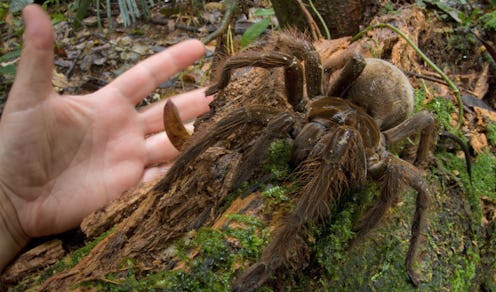News
Like Puppies? What About This Puppy Sized Spider?

Arachnophobes, please, look away. Harvard University entomologist and photographer Piotr Naskrecki recently had a close encounter with a furry jungle creature, which he initially thought was "a small mammal," but turned out to be a giant South American Goliath Birdeater spider. I never, ever want to use the word "puppy" to describe a spider ever again. But unfortunately for Naskrecki, a late-night stroll in a Guyana rainforest quickly became a walk through the pages of the Guinness Book of World Records as he encountered what is reputed to be the planet's largest species of spider. Shudder.
According to Naskrecki's blog post about the terrifying encounter, the photographer initially set out on a quest for katydids in the South American rainforest. But instead of finding small insects, he found the world's largest spider. With legs that can grow up to a foot long, or as Naskrecki told Live Science, the size of "a child's forearm," the spider is perhaps the single most terrifying animal to be found in Guyana. And worse yet, because the spider is so big, it actually produces audible footsteps when it walks. Naskrecki wrote in his blog,
Its feet have hardened tips and claws that produce a very distinct, clicking sound, not unlike that of a horse’s hooves hitting the ground.
This sounds like the worst version of the apocalyptic Four Horsemen ever.
Of course, on the bright side, at least this "clicking sound" would warn you of the spider's approach, and give you ample time to run screaming in the opposite direction. But are these spiders actually dangerous to our species?
According to Naskrecki, apparently not. While the spider is certainly venomous, its bite is not deadly to humans. But don't get too comfortable — the spider delivers its venom by way of its enormous, two-inch long fangs. If you were so unlucky as to receive a bite from one of these spiders, Naskrecki says that the sensation would be similar to "driving a nail through your hand."
Worse yet, the spider has another two lines of defense to keep itself safe (although from what, I'm not entirely sure). As if its two-inch long venom-producing fangs weren't enough, the birdeater also sports a coat of "microscopic hooks" that the spider rubs together, producing a hissing sound that will scare even the most ferocious of predators away. And to top it all off, the birdeater also has the ability to shoot clouds of these microscopic hooked hairs towards an attacker, which become lodged in the skin and cause human victims to "itch and cry for several days."
But don't worry, Naskrecki told Live Science. Despite all these lines of defense and otherwise petrifying spider super-powers, the world's largest spider is actually less dangerous than a farm animal. As Naskrecki said, "A chicken can probably do more damage." I don't know what kind of chickens Naskrecki has met, but I'm staying as far away from his farm as humanly possible.
So if the South American Goliath Birdeater doesn't actually feast upon human flesh, then what does it eat? Its name would suggest that the arachnid dines upon our feathered friends, but birds are not, in fact, the main component of this spider's diet. While the birdeater does possess a great many capabilities, flying is not one of them, and as such, catching birds would be quite the task for the spider. That being said, if a bird's nest is within reach, the spider has been "known to puncture and drink bird eggs." But for the most part, its main prey is found on the ground. Naskrecki noted, "They will essentially attack anything that they encounter." What a comforting thought!
That means that the birdeater is actually capable of killing and eating small mammals, like mice and other rodents, who are unlucky enough to cross its path. After all, with two inch fangs, these spiders are certainly "capable of puncturing a mouse’s skull." In the Guyana rainforest, however, the main source of the birdeater's food is actually earthworms, which Naskrecki told Live Science, "are very nutritious."
Perhaps most terrifying of all is the life span of these gargantuan arachnids. Female birdeaters, who eat the males after mating, can live for up to 30 years. Birdeaters then, are older, and likely wiser, than many college students. Imagine that.
Being a true man of science, Naskrecki did not flee from the birdeater, but rather embraced the opportunity to be in the presence of such a rare and unique animal, even going so far as to call it "cute." He took the first birdeater (yes, there were more) he encountered back to his lab, where he further studied the animal before sending her off to a museum. And when he encountered his second giant spider a few years later, he thought to himself, "...it’s just another Goliath birdeater. Aren’t you a cutie pie?"
Images: RealMonstrosity,